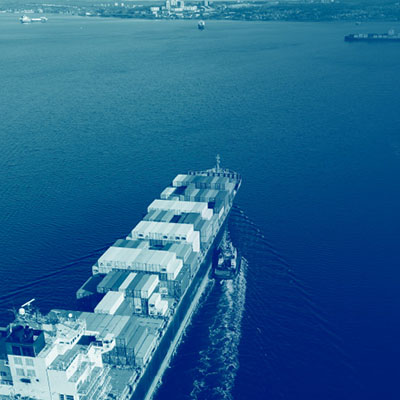Published: June 28, 2025

Retailers are gearing up for their annual “Christmas in July” sales, but this year, the early holiday cheer comes with a warning: escalating tariff whiplash may lead to higher prices, fewer options, and major delays for shoppers come December. Behind the scenes, businesses are scrambling to forecast demand and lock in orders for the back-to-school and winter holiday seasons — but unpredictability in trade policy is breaking the very tools they rely on to plan.
In this episode, I’m joined by Debdatta Sinha Roy, a principal scientist in O.R. and data science at Oracle Retail Science R&D, to explore how this volatility is creating an invisible crisis within the analytics systems that power global logistics, and what a better path forward could look like. From smarter sourcing strategies to more stable policymaking, we’ll discuss what it will take to bring long-term resilience to today’s fragile supply chains — as retailers and consumers alike are already feeling the impact on the holiday shopping season.
Supply chains rely on predictability. Whether you're forecasting demand, scheduling shipments, or planning production, our analytics models need stable assumptions—for example, lead times, costs, trade regulations. When those inputs fluctuate—like when tariffs are announced, paused, or reversed in rapid succession—the entire foundation of the models collapses. Businesses can adapt to higher costs, but they can't easily plan around volatility. It's like trying to navigate with a GPS where the map keeps changing.
Interviewed this episode:

Debdatta Sinha Roy
Oracle
Related Episodes
Episode Transcript
Ashley K:
Welcome to the latest episode of Resoundingly Human, the podcast brought to you by INFORMS leading association for professionals and students who apply science, math, technology, and analytics to make smarter decisions for a better world. I’m your host, Ashley Kay, and thank you for joining me to explore how informs members are saving lives, saving money, and solving problems. Hi everyone. A quick message before we dive into this episode. Resoundingly Human will be taking some time off this summer, but it won’t be for rest and relaxation. We’ll be hard at work on a refresh and some great new content. So enjoy this episode and we’ll see you again in the fall.
Retailers are already gearing up for their annual Christmas in July sales, but this year the early holiday cheer comes with a warning. Escalating tariff whiplash may lead to higher prices, fewer options and major delays for shoppers come December. Behind the scenes, businesses are scrambling to forecast demand and lock in orders for the back to school and winter holiday seasons. But unpredictability and trade policy is breaking the very tools they rely on to plan. In this episode, I’m joined by Debdatta Sinha Roy, a principal scientist in O.R. and data science at Oracle Retail Science R&D, to explore how this volatility is creating an invisible crisis within the analytic systems that power global logistics and what a better path forward could look like. From smarter sourcing strategies to more stable policymaking, we’ll discuss what it will take to bring long-term resilience to today’s fragile supply chains as retailers and consumers alike are already feeling the impact on the holiday shopping season. Deb, thank you so much for joining me to share your expertise. Before we jump in, can you give our listeners a little background on the work you’ve done in the area of tariffs and supply chain resiliency?
Debdatta Sinha Roy:
Good afternoon and thank you for having me on your podcast. So my work in supply chain resiliency really accelerated during the COVID-19 pandemic when traditional logistics models broke down almost overnight. I was at Staples back then where I helped redesign some essential transportation and delivery operations problems to respond to certain disruptions in demand and fulfillment. Since joining Oracle Retail, I have been co-leading the AI foundation product, which involves building robust analytics solutions for retail clients across sectors from fashion to grocery to electronics. My research focuses on making data-driven decisions under uncertainty, and tariffs are a prime example of uncertainty. These are policy changes that disrupt the data pipelines and assumptions our models depend on.
Ashley K:
Alright, how about we start with the basics. What was the original goal of US tariffs and how did they intend to address vulnerabilities in the supply chains?
Debdatta Sinha Roy:
The primary intent behind us tariffs was to reduce reliance on foreign supply chains and encourage domestic manufacturing, especially in critical sectors. The idea was to promote economic independence and national resilience, but the challenge is tariffs were introduced abruptly without the necessary domestic infrastructure or manufacturing capabilities in place. So instead of strengthening supply chains, they created immediate cost pressures and operational disruptions. Tariffs can be a long-term strategic tool, but only when phased in with supportive policies, investment in capacity manufacturing and workforce development.
Ashley K:
So now you’ve previously stated that uncertainty, not tariffs themselves caused the most disruption. Could you explain why unpredictability is so damaging to supply chains?
Debdatta Sinha Roy:
Absolutely. Supply chains rely on predictability whether you are forecasting demand scheduling shipments, or planning production, our analytics models need stable assumptions. For example, lead times costs, trade regulations. When those inputs fluctuate, like when tariffs are announced, paused or reversed in rapid succession, the entire foundation of the morals collapses. Businesses can add up to higher costs, but they can’t really easily plan around volatility. It’s like trying to navigate when with a GPS where the map itself keeps changing.
Ashley K:
What happens to supply chain forecasting when a stable regulatory environment is missing?
Debdatta Sinha Roy:
Yeah, forecasting becomes guesswork. Our models are data-driven and built on historical patterns. When the regulatory environment is unstable, historical data becomes less reliable and the assumptions behind cost structures, delivery times and supplier capacities fall apart. In such scenarios, even the most advanced operations research tools lose their predictive power. You may still run the models, but the outputs owned guide decisions in a meaningful way. During COVID, we had to pivot quickly to alternative data sources like lockdown data from CDC and other public agencies with tariffs. There’s no equivalent unified data feed to plug into.
Ashley K:
So with Christmas and July promotions about to begin, what are some of the real risks that shoppers and retailers like could face this holiday season?
Debdatta Sinha Roy:
The biggest risks are price hikes, fewer product choices and delays. Retailers are already placing large orders now for the end of year season. If tariff rates spike or sourcing disruptions or mid-cycle costs go up and inventory plans fall apart, some retailers may overstock now to hedge against future tariffs driving up storage costs and tying up working capital. Others may scale back leading to under stock shelves later. For consumers, this could mean paying more for less, especially on high demand items like electronics, clothing, and event school supplies.
Ashley K:
So it might sound to sound like it’s a little crazy. We’re already talking about holiday shopping, but how is this mid-year tariff uncertainty affecting critical planning windows for back to school and end of year inventory? Can businesses recover in time if policy shift? Again,
Debdatta Sinha Roy:
It’s a huge problem because we’re already deep into the planning cycle. Retailers typically finalize major orders between May and July. That’s when shipping containers are booked, suppliers are locked in and budgets are committed. Any major tariff shift now means businesses are stuck making urgent decisions with limited flexibility. Even if policy stabilize later this year, the lead times in manufacturing and global transport mean it may be too late to course correct. Recovery from such mid-cycle disruptions usually isn’t measured in weeks, but in seasons
Ashley K:
We’ve seen policymakers frame tariffs as a show of strength, especially in response to foreign tariffs. Do you think this sort of tit for tat approach may ultimately harm US businesses more than help them?
Debdatta Sinha Roy:
In theory, reciprocity in trade policies make sense, but in practice, fit for tat approaches without strategic coordination tend to hurt domestic businesses. The most supply chains operate on long planning horizons 12 to 18 months or more sudden changes derail that entire planning cycle. Retaliatory tariff might sound strong politically, but if it disrupts sourcing or causes ripple effects across logistics and pricing, it often ends up harming the very businesses it aims to protect the key strategic phased responses, not abrupt escalations.
Ashley K:
So the data tariffs aren’t the answer. What would a more sustainable and strategic approach to domestic self-sufficiency look like?
Debdatta Sinha Roy:
We need a long-term game plan. That means investing in infrastructure, technology, and workforce training to scale domestic manufacturing. Gradually targeted economic incentives like tax credits, r and d funding and public private partnerships can help build viable local alternatives. Policies should align with realistic timelines for capability development. A rush to reshoring without planning leads to bottlenecks and cost explosions. Building resilience should be about capability, not compulsion.
Ashley K:
So I’d love to hear your perspective. In your view, how should companies rethink their approach to global sourcing, especially regarding countries like China?
Debdatta Sinha Roy:
The post COVID world has shown us that concentrated sourcing is risky. Companies need to diversify through nearshoring, multi-sourcing and developing regional supplier networks. That doesn’t mean abandon abandoning China overnight, but rather reducing overdependence. This could mean blending sourcing from China with partners in Mexico, Southeast Asia, or even domestic suppliers depending on the product category. Resilience lies in optionality, being able to pivot when needed without starting from scratch.
Ashley K:
And finally, what steps can business leaders take today to build more agile and resilient supply chains? In the face of ongoing policy shifts,
Debdatta Sinha Roy:
Agility starts with mindset and data readiness. First, leaders should invest in scenario planning tools that simulate different policy environments. Second, supply chain contracts should be flexible, able to absorb some degree of fluctuation. Third, safety, stock and buffer capacity can no longer be seen as inefficiencies. Their insurance against disruption. Finally, closer. Collaboration with suppliers and real-time visibility into the supply chain are vital. The best prepared companies owned with those with perfect predictions, but those with the ability to adapt quickly and intelligently.
Ashley K:
Debdatta, thank you so much for taking time to share your special insight on this very complex and still evolving issue. It’s been such a pleasure speaking with you.
Debdatta Sinha Roy:
Likewise. Thank you for having me. It’s a critical conversation and I’m glad to contribute.
Ashley K:
If you’d like to learn more about today’s episode and guest, visit resoundingly human.com and check out our show notes. The podcast is also available for streaming and download on Amazon Music, apple Podcasts, Google Podcasts, and Spotify. Wherever you listen, please be sure to leave a five star review to help others find and enjoy the podcast. Until next time, I’m Ashley Kay and this is resoundingly human.
Want to learn more? Check out the additional resources and links listed below for more information about what was discussed in the episode.
How Big Data Make (or Break) Your Online Shopping, OR/MS Today
How Generative AI is Revolutionizing E-Commerce Operations, Innovation & Technology Today
Why Santa Claus Does Best When He Overestimates Demand, Parcel
14 Moves to Master Demand Surges, Inbound Logistics
Tags: holiday shopping, retail, supply chains, tariffs, trade



